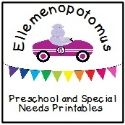
My kids absolutely loved this game. Here's what you do: Gather together several small objects that your children can sort. We used puff balls, Cheerios, cloth buttons, jelly beans and kidney beans. Mix all the objects in a container. Have your children sort the objects into different categories. The challenge is that they may not use their fingers to pick up the objects; they must tweeze each object using some tweezers (we just used the tweezers from our pretend medical kit, but eyebrow tweezers would work too). We used a muffin tin for sorting, but if you don't have a muffin tin, use a piece of paper divided up into sections, or just use several different Tupperware containers.
My three year old really got into this activity. First he sorted by object, putting all the jelly beans in one container, all the buttons in one, and so on. Then, because he was really into the jelly beans, he decided to sort the jelly beans by color. He did find the tweezing difficult, and ended up using his fingers for most of the activity, but still gave the tweezers a go for a little while. When he was ready to put everything away, I had him experiment with which objects were easier to tweeze and which were more difficult. We discovered that the rough objects (like the cloth buttons and the Cherrios) were easy to pick up and the smooth objects like the beans were more difficult. This led into a discussion on texture.


My two year old really couldn't do the tweezers, though I did encourage her to try. However, she absolutely loved sorting! She sorted all her objects three times before getting bored! I noticed as well that she put the jelly beans and kidney beans in the same compartment, meaning she was sorting them in the general category of "beans", while my 3 year old was able to distinguish two more specific categories of "jelly beans" and "kidney beans".
This activity is so great for so many reasons. Not only is it fun for your kids, but it provides some wonderful opportunities to fine tune their pre-math skills. Spend time talking and experimenting with different ways to sort the objects and take the opportunity to talk about texture and shape, letting the children explore the different objects with the fingers. The tweezing aspect gives them a chance to work on those fine motor skills which will be so helpful once they start writing and drawing.
 I decided to give this classic child's craft a try the other day. I dyed our noodles using the same method that I used to dye the rice; 2 tsp rubbing alcohol plus food coloring, then shake the colors in separate ziplock bags. The noodles take a little longer to dry than the rice, so be patient and prepare ahead of time. Then I cut long strips of yarn for stringing. I made a little "needle" out of a pipe cleaner and we had fun making these pretty neclaces. I've made this a permanent activity on our "preschool" shelf at our house; instead of yarn, I am using a shoelace with masking tape on the end for a needle. The kids have picked this up several times since we did this activity, and enjoy just making the long strings of noodles and then pulling them off one at a time and putting them away. Try it! Your kids may like this too!
I decided to give this classic child's craft a try the other day. I dyed our noodles using the same method that I used to dye the rice; 2 tsp rubbing alcohol plus food coloring, then shake the colors in separate ziplock bags. The noodles take a little longer to dry than the rice, so be patient and prepare ahead of time. Then I cut long strips of yarn for stringing. I made a little "needle" out of a pipe cleaner and we had fun making these pretty neclaces. I've made this a permanent activity on our "preschool" shelf at our house; instead of yarn, I am using a shoelace with masking tape on the end for a needle. The kids have picked this up several times since we did this activity, and enjoy just making the long strings of noodles and then pulling them off one at a time and putting them away. Try it! Your kids may like this too! 



















 Besides being cute, what I liked about this project was that it required my little ones to follow directions, pay attention to detail and color, and work with a glue pen and the fine kernels of rice.
Besides being cute, what I liked about this project was that it required my little ones to follow directions, pay attention to detail and color, and work with a glue pen and the fine kernels of rice. To do this project, you will need colored rice (see my posts under "fun with foods" for instructions on dying rice), a piece of construction paper and glue--I used a glue pen. Have your child draw (or draw it yourself) an arch with the glue. Then have them add red rice as you would add glitter, to the arch. Repeat, varying the colors until you have a completed rainbow. You can use this activity to talk about the letter "R" because both rice and rainbow begin with R.
To do this project, you will need colored rice (see my posts under "fun with foods" for instructions on dying rice), a piece of construction paper and glue--I used a glue pen. Have your child draw (or draw it yourself) an arch with the glue. Then have them add red rice as you would add glitter, to the arch. Repeat, varying the colors until you have a completed rainbow. You can use this activity to talk about the letter "R" because both rice and rainbow begin with R. 

 An activity like this is a wonderful learning tool to help teach a child about cause and effect, and it develops manual dexterity. My children both had a great time with this activity, especially my 2 year old. She kept at it for 30 minutes or so, and I know she'll be asking to do this one over and over. I hope your little ones enjoy this as much as mine did!
An activity like this is a wonderful learning tool to help teach a child about cause and effect, and it develops manual dexterity. My children both had a great time with this activity, especially my 2 year old. She kept at it for 30 minutes or so, and I know she'll be asking to do this one over and over. I hope your little ones enjoy this as much as mine did!  I had read about how to dye rice different colors and so we gave it a try this week. First, I poured about a half a cup of brown rice (any kind of rice will do, I just used brown rice because that's what we had) into several different
I had read about how to dye rice different colors and so we gave it a try this week. First, I poured about a half a cup of brown rice (any kind of rice will do, I just used brown rice because that's what we had) into several different  Once the rice had dried, which took about two hours, I poured each color onto a plate. From there, I showed the kids how to draw and make designs or letters in the rice. We drew shapes, tried to make hand prints, drew with a pencil in the rice, we even tried cookie cutters on the rice! The first picture my son made he lifted up the plate to show me, spilling half the rice on his plate. It was okay; he learned a valuable lesson about gravity from the experience! Both kids got really creative with their drawings. They enjoyed the sound of the rice against the paper plates, the feel of it between their fingers, the way it looked dropping from their hands like rain, and even the smell. They especially loved the colors! They had to learn to be gentle and show restraint or otherwise they'd spill all the rice on their plates.
Once the rice had dried, which took about two hours, I poured each color onto a plate. From there, I showed the kids how to draw and make designs or letters in the rice. We drew shapes, tried to make hand prints, drew with a pencil in the rice, we even tried cookie cutters on the rice! The first picture my son made he lifted up the plate to show me, spilling half the rice on his plate. It was okay; he learned a valuable lesson about gravity from the experience! Both kids got really creative with their drawings. They enjoyed the sound of the rice against the paper plates, the feel of it between their fingers, the way it looked dropping from their hands like rain, and even the smell. They especially loved the colors! They had to learn to be gentle and show restraint or otherwise they'd spill all the rice on their plates. 
 This was a really fun activity that we will probably do again and again. Not only that, but I had another activity in my mind for the rice, which I'll be posting on here soon!
This was a really fun activity that we will probably do again and again. Not only that, but I had another activity in my mind for the rice, which I'll be posting on here soon!
 For today's activity, we did orange printing, which I've seen recently on one of my favorite blogs, and in books as well. First, I took a small orange and cut it cross-wise. If you cut top to bottom, it will still work, but a cross cut gives it a much more interesting print. Then I dropped a bit of paint into three separate paper bowls. I set half an orange in each bowl and swished it around a bit to cover the entire bottom surface of the fruit. Then I let my kids have at it, using the oranges like stamps on white construction paper. I discovered the oranges were a little difficult for my two year old to grasp due to the suction of the orange to the paint, so I poked a fork into each orange for use as a handle.
For today's activity, we did orange printing, which I've seen recently on one of my favorite blogs, and in books as well. First, I took a small orange and cut it cross-wise. If you cut top to bottom, it will still work, but a cross cut gives it a much more interesting print. Then I dropped a bit of paint into three separate paper bowls. I set half an orange in each bowl and swished it around a bit to cover the entire bottom surface of the fruit. Then I let my kids have at it, using the oranges like stamps on white construction paper. I discovered the oranges were a little difficult for my two year old to grasp due to the suction of the orange to the paint, so I poked a fork into each orange for use as a handle. 

 The kids were intrigued that we were using food to make art, and enjoyed the novelty of using food in such a way. They also liked that the oranges smelled so juicy! The prints turned out really neat. All in all, this was an enjoyable little activity. And of course, we ended the activity by eating a nice, clean orange for snack!
The kids were intrigued that we were using food to make art, and enjoyed the novelty of using food in such a way. They also liked that the oranges smelled so juicy! The prints turned out really neat. All in all, this was an enjoyable little activity. And of course, we ended the activity by eating a nice, clean orange for snack!

 We whipped up a batch of new yellow playdough and then smooshed it into little pancakes on the sliding glass door. You could also try using a wall or the fridge; any vertical surface will do. Then we dug out the rubber stamps to make imprints and the cookie cutters to make some nice shapes. What fun, and oh, the novelty of trying an old activity in a new way! The kids really loved this, and I loved seeing how they had to use arm muscles in ways they had never had to in previous play.
We whipped up a batch of new yellow playdough and then smooshed it into little pancakes on the sliding glass door. You could also try using a wall or the fridge; any vertical surface will do. Then we dug out the rubber stamps to make imprints and the cookie cutters to make some nice shapes. What fun, and oh, the novelty of trying an old activity in a new way! The kids really loved this, and I loved seeing how they had to use arm muscles in ways they had never had to in previous play.
 Going vertical uses upper arm muscles in a unique way that horizontal play doesn't allow for. I loved seeing my kids using those muscles to make sure their pancakes stayed put on the door. Try this activity and let me know how it goes for you!
Going vertical uses upper arm muscles in a unique way that horizontal play doesn't allow for. I loved seeing my kids using those muscles to make sure their pancakes stayed put on the door. Try this activity and let me know how it goes for you!



 This activity is so great because it deals with several different areas of learning. Children learn to match and sort the shapes, work with a sticky medium like glue, and they get a really tactile experience handling all the different materials. It's a great verbal booster as well. You can use the opportunity to talk to your child about how each material feels, whether it's durable or fragile, whether it's quiet or crinkly, soft, smooth or rough. My kids just loved this activity, so it was well worth the extra time it took to gather and cut out the materials. I have a feeling it will be gracing our fridge for many months to come.
This activity is so great because it deals with several different areas of learning. Children learn to match and sort the shapes, work with a sticky medium like glue, and they get a really tactile experience handling all the different materials. It's a great verbal booster as well. You can use the opportunity to talk to your child about how each material feels, whether it's durable or fragile, whether it's quiet or crinkly, soft, smooth or rough. My kids just loved this activity, so it was well worth the extra time it took to gather and cut out the materials. I have a feeling it will be gracing our fridge for many months to come. 
.JPG)




 My two year old had a great time with the finger paints too. What I like about finger painting is that it's such a tactile experience for the kids. My two year old especially likes squeezing the paint between her fingers and rubbing it in globs on the paper. It doesn't matter if it doesn't look all that great in the end. This activity is all about the journey, and not the product. I hope your little ones enjoy this as much as mine did!
My two year old had a great time with the finger paints too. What I like about finger painting is that it's such a tactile experience for the kids. My two year old especially likes squeezing the paint between her fingers and rubbing it in globs on the paper. It doesn't matter if it doesn't look all that great in the end. This activity is all about the journey, and not the product. I hope your little ones enjoy this as much as mine did! 




















